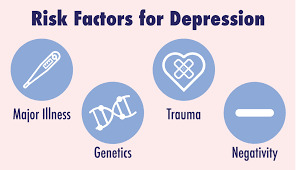What are the different ways to treat depression?
Depression is a mood disorder characterized by sadness and loss of interest, also known as major depression or clinical depression. It affects how you feel, think, behave, and can lead to a variety of emotional and physical problems. In addition to causing emotional and physical problems, it can also make it difficult for you to function at work and at home.
Risk factor of depression
Depression can happen at any age, but often begins in teenage or adulthood. It is now recognized that depression can occur in children and adolescents, although occasionally the symptoms manifest more as irritability than depression. In many cases, chronic anxiety and mood disorders in adults begin as high levels of anxiety in children.

Following are the conditions that is associated as a high risk for the cause of depression.
- experiencing certain life events
- having a chronic condition or cardiovascular disease
- living with chronic pain
- lacking social support
- having had a previous episode of major depression
- having a lack of successful coping strategies
- experiencing acute stress
- using recreational drugs, such as alcohol or amphetaminessustained a head injury
- having a neuro degenerative disease such as Alzheimer’s or Parkinson’s
- having a close relative with depression
- using some prescription drugs
Treatments:
It is possible to treat depression. The majority of people, however, do not react to treatment immediately and may need to combine treatments or try multiple drugs to get relief. The majority of people who suffer from depression remit their symptoms within 12 months, but it can return at any time.

The most effective treatment for your symptoms may be a combination of treatments, or you may find that one form of treatment is enough to manage your symptoms. Apart from medicine therapy usually adopted by most of the depressed people, in many cases, medical treatments are combined with lifestyle therapies, such as:
1. Psychotherapy:
You can learn skills to cope with negative feelings by speaking with a therapist. The services of a family therapist or a group therapist may also be of benefit to you. The goal of psychotherapy, also known as “talk therapy,” is to identify and cope with the factors contributing to a mental health condition, such as depression.
Psychotherapy has been proven to be effective treatment of depression and other psychiatric disorders. A combination of psychological therapy and pharmaceutical treatment is often used. Various types of psychotherapy are available, and some people respond better to certain types.
2. Cognitive behavioral therapy (CBT):
The goal of cognitive behavioral therapy (CBT) is to uncover unhealthy patterns of thought and identify how they may lead to harmful behaviors, reactions, and beliefs.
It is possible that your therapist will assign you “homework” in which you need to practice replacing negative thoughts with more positive ones.
3. Dialectical behavior therapy (DBT)
Unlike cognitive behavioral therapy (CBT), dialectical behavior therapy (DBT) emphasizes acceptance of uncomfortable thoughts, feelings, and behaviors rather than fighting them.
It is believed that if you accept that change is possible and make a recovery plan, you will be able to change your harmful thoughts or emotions.
4. Psychodynamic therapy:
Talk therapy, or psychodynamic therapy, can help you cope with your everyday life more effectively. Psychodynamic therapy is based on the principle of that the reality you live in today is shaped by your unconscious childhood experiences.
As part of this form of therapy, your therapist will help you reflect on and examine your childhood and experiences in order to help you cope and understand your present situation.
5. Light therapy:
White light can help regulate your mood and reduce depression symptoms. A common use of light therapy is in the treatment of seasonal affective disorder, which has now been renamed major depressive disorder with seasonal pattern.
6. Electroconvulsive therapy (ECT):
People with clinical depression can benefit from electroconvulsive therapy (ECT), which uses electrical currents to induce seizures. Those with severe depression or depression that hasn’t responded to other treatments or antidepressants are prescribed this medication. In an ECT procedure, you will be administered an anesthetic agent, which will cause you to fall asleep for approximately 5-10 minutes.
An electrode will be placed on specific areas of your head and cardiac monitoring pads will be placed on your chest. Short electric pulses will be passed through them for several minutes. There will be negligible feeling of those pulses un your body and you will wakeup after several minutes.
Patients may also develop memory problems, but these usually reside in the weeks and months after treatment.
REFERENCES:
- https://www.medicalnewstoday.com/articles/8933
- https://www.healthline.com/health/depression
- https://www.nimh.nih.gov/health/topics/depression
- https://www.who.int/news-room/fact-sheets/detail/depression
- https://psychiatry.org/patients-families/depression/
- https://www.mayoclinic.org/diseases-conditions/depression/symptoms-causes/syc-20356007
For more details, kindly visit below.
Suggested keywords signs of depression | depression and anxiety | causes of depression | depression treatment | severe depression | therapy for depression | fighting depression | mild depression.